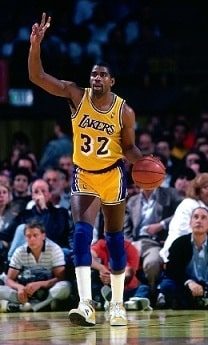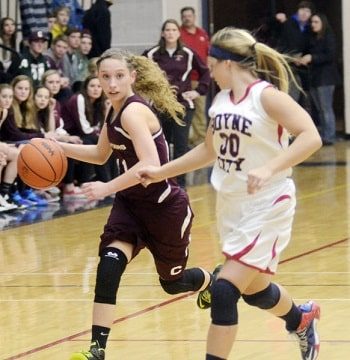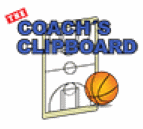Basketball Dribbling and Dribble Moves
By Dr. James Gels, From the Coach’s Clipboard Basketball Playbook"Helping coaches coach better..."
All players must learn how to dribble as dribbling is one of the most fundamental basketball skills. Not only is it important to learn how to dribble well, but it is important to know when, and when not, to dribble. One player who over-dribbles can kill a team's offensive motion and momentum. To become a good dribbler and ball handler, you must practice dribbling as often as you can, using each hand. This article discusses this basic fundamental and several dribble moves.
Coach, looking for an organized library of helpful basketball information? Coach's Clipboard is a long-standing trusted basketball coaching resource used by coaches worldwide, at all levels - a basketball coach's encyclopedia.
Watch Video Register now
Disclosure: This page contains affiliate links, which means that Coach's Clipboard receives a small commission (at no cost to you) if you make a purchase using these links.Watch Video Register now
You may dribble:
1. To advance the ball up the court.
2. To drive to the hoop.
3. To get open for a shot.
4. To open up a passing lane, to have a better chance of completing a pass.
5. To get out of a trap.
6. To kill the clock at the end of a game.

Earvin "Magic" Johnson
How to Dribble
Use your fingertips, not the palms of your hands. Basketball is played on the tips of your fingers and the balls of your feet. Use your forearm and wrist to bounce the ball. Don't look at the ball - keep your head up and eyes forward. Learn to use either hand. So when doing drills, always work both hands."Control Dribble" (when the defender is up close on you)
When a defender is guarding you closely, you should use the "control dribble". Keep in a somewhat crouched, bent over position. Keep your body between the ball and the defender. Keep the ball low to the floor, behind and close to your body. Keep your other arm straight out in front of you, as a guard against the defender.You can't push off, or grab the defender, but you can use your "arm-bar" to keep the defender from reaching around you. Do not stop your dribble until you can either pass or shoot.
Xavier head coach Sean Miller calls it the "glide dribble"... from his DVD "Beating Pressure Defenses":
"Speed Dribble" (in the open court)
To move the ball quickly up the floor use the "speed dribble". Push the ball forward, ahead of you several feet. Bounce the ball at least waist high. Keep your head up, and visualize the whole court, so you can find the open teammate.
Crossover Dribble
Simply, the crossover dribble has you switch dribbling from one hand to the other, by bouncing the ball in front of you across to the other side. Then the other hand picks up the ball and you are now dribbling with the opposite hand.You can use this dribble to quickly change your direction on the court. For example, you could be on the point, dribbling with your right hand to the right wing, then suddenly crossover the dribble to the left and drive up the lane.
Here's another cross-over video
In and Out Dribble
The "in and out" dribble is a good fake move to help you get around a defender and take it to the hoop. With this move, you make one bounce in front of you as if you were going to crossover, but instead of picking the ball up with your other hand, you just roll your dribbling hand over the top of the ball, and bring it sharply back and go hard around the defender.For example, if you are dribbling right-handed, make one dribble to the left in front of you and "dip" and put your weight on your left foot. To the defender, this looks like you will crossover and go left. Instead, roll your right hand over the top of the ball and bring it back quickly to the right, push off the left foot, and go hard around the right side of your opponent.
Hesitation Dribble ("Rocker Move")
This is another fake move to help you get around the defender in the open court. You speed dribble up to the defender, then suddenly come to a stop by putting your inside foot forward and "rocking" backward onto your outside foot. Then as the defender closes, you blow around his side, resuming the speed dribble, straight to the hoop.For example, you are speed dribbling with your right hand. As you approach the defender, you stop suddenly by putting your left foot forward, and then rocking back on the right foot. This hesitation throws the defender's timing off. Then push hard off the right foot, and speed dribble around his right side. You can also use this move and combine it with a crossover dribble and go hard left.
Behind the Back Dribble, Through the Legs Dribble
You used to be considered a "hot dog" if you dribbled behind your back, or through your legs. But not any more! These moves are very useful when used correctly, in the right situations.A good use for these dribbles is in the open court, such as a guard bringing the ball down the floor against pressure from a defender. As you are dribbling right with your right hand, the defender gets position and over-plays you to the right. Quickly, you do a behind the back, or between the legs dribble to crossover to the other hand, and change your direction to the left, leaving your defender in the dust!
Why not just do an easier crossover dribble? -- because the defender is right in front of you and could steal the crossover. By going behind the back, or through the legs, you can better protect the ball by keeping your body between the ball and the defender.
To do the behind the back dribble, dribble the ball once behind you and pick up the dribble with the opposite hand. For example, you are dribbling with the right hand. Get your body ahead of the ball on your right side, then crossover bounce it once behind you over to the left hand.
The between the legs move is similar, except with one bounce through the legs to the other hand.
Spin Move
The spin move is an excellent move to get around a defender in the open court. But be careful of a defender stealing the ball from behind, on your "blind side" as you make the spin. When making the spin, reverse pivot (spin) on your front foot, and pull the ball hard and quickly around your body. Don't let your hand get under the ball (a "carrying" violation). Then continue the dribble with the opposite hand.Back-up Dribble and Crossover
The back-up dribble is useful in retreating from a defender or a trap. Dribble backwards and then do a quick crossover dribble (or a through the legs dribble or around the back dribble) to get free.Have your players practice each of these dribbles every practice for 5-10 minutes. Have them line-up along the sideline, and dribble from sideline to sideline right-handed, and then back left-handed. Do each of the moves down and back twice before moving onto the next move. See Sideline Dribbling Drills, Dribbling Moves Drill.
Players can also use these drills at home individually. Set up cones or folding chairs (see Tight Chairs Dribbling Drills), pretending the cone (or chair) is the defender. Make your move quickly right in front of the defender. Once you get past the cone (or chair) turn around and attack it from the opposite direction with your other hand.
From Coach Joe Wootten: Coach Wootten's Basketball Camp:
Breaking Down Your Defender - Ball Handling and Passing Drills
Related pages:Breaking Down Your Defender - Ball Handling and Passing Drills
- Stationary Dribbling Drills
- 2-Ball Dribbling Drills
- Tight Chairs Dribbling Drills
- Sideline Dribbling Drills
- Dribbling Moves Drill
Get the Coach's Clipboard Playbook download for many larger, good quality video clips of ball-handling and dribbling drills (and more), along with audio from Coach Gels.


